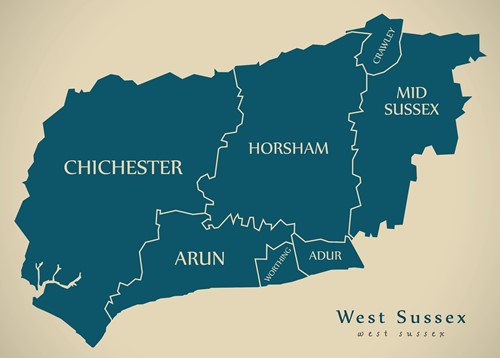Our people and places
- Home - Connect to Support
- Working Together
- Our people and places
- Our people and places

West Sussex is a large and diverse county covering an area of 769 square miles with over half the land designated as protected countryside. It has a population of 892,400 with 715,100 people aged 18 and over which makes up 80% of the total population, slightly higher than the regional and national average.
From 2011 to 2021, the population of West Sussex increased by 9.4% to 882,700 (75,800 more) compared to an increase in the South East region of 7.5% and England 6.6%. The largest percentage increase in population was among those aged 70-74 years for both male and female. There were 44% more people in this age group compared to 2011. The population aged 65 years and over make up 23% of the total population of the county, an increase from 21% in 2011 and a larger proportion that nationally at 18.6%.
The population in West Sussex is projected to increase by 8% from 2018 to 2028 with larger increases in the 65+ age group (23%) and notably in the 85+ age group (28%).
Overall, people enjoy a good quality of life with a relatively high life expectancy of 82.5 years when compared with England 81.4 years. Life expectancy for men is 80.3 years (England 78.9 years) and 84.2 years for women (England 82.8).
In 2018-20, the male healthy life expectancy was 63.8 years and the female 63.9 years, which is in line with the national level.
Health inequalities persist
The average life expectancy in West Sussex masks considerable inequality, and differences between areas and different groups within the population.
Although West Sussex is a relatively affluent area, some neighbourhoods in Arun and Crawley rank amongst the 10% most deprived in England, and there remain considerable differences between the life expectancy of the wider population and people with mental health problems and those with disabilities, including learning disabilities.
People from lower income groups are more likely to be in poorer health, have a limiting long-term illness and lower life expectancy.
Men living in deprived areas have 6.9 fewer years in life expectancy and women have 5.8 fewer years. These are both lower than for England.
To find out how the West Sussex Health and Wellbeing Board is working to reduce health inequalities and to ensure better quality of services for all, please read the Board’s West Sussex Joint Health and Wellbeing Strategy 2019-24.
Data from the 2021 Census indicates that:
- The proportion of the population who are of minority ethnicities has increased, rising from 11.1% in 2011 to 15.8% in 2021.
- Crawley has seen the greatest overall increase in residents of minority ethnicities, rising from 27.9% in 2011 to 38.2% in 2021. Mid Sussex and Worthing have seen the next greatest increases with the proportion of the population who are of a minority ethnicity increasing from 9.7% to 14.2% in Mid Sussex and from 10.6% to 15% in Worthing.
- Around 49,850 people do not speak English as their main language. Polish remains the most common minority main language with 8,280 speakers (up from 6,300 in 2011).
- Over 73,000 unpaid carers. This figure is likely to be considerably higher as many people do not identify themselves as carers.
- Over 30% of people aged 65 years and over live alone, representing over 60,000 people.
- Around 16% of residents are disabled, with 10% regarding themselves limited a little and 6.1% as limited a lot. This figure is slightly lower compared to 2011 - 17.2%.
- At any one time it is estimated that one in six adults have a common mental health problem.
- Around 18,000 people aged 65 years and over are estimated to have a moderate to severe visual impairment.
- There are an estimated 2,750 people aged between 18 and 64 years with a moderate or severe learning disability.
- It is estimated that there are 8,772 adults (18+ years) living with autism.
- Over 14,830 people are estimated to have dementia. This figure is forecast to rise to approximately 21,750 by 2040 in line with the ageing population.
Population estimates play a crucial role in our commissioning and strategic planning. Public Health also supports us to improve understanding of future needs and recently this has involved forecasting future co-morbidity prevalence (the number of individuals living with more than one illness or disease at the same time) and dependency for over 65s in the county. A summary of this work is available on the Council’s Joint Strategic Needs Assessment (JSNA) website.







